 |  |
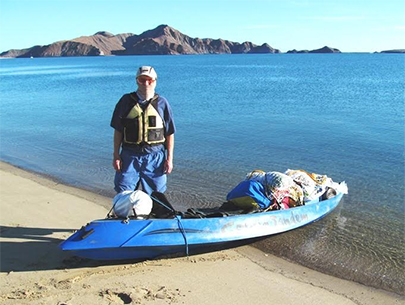
On the face of it, it didn’t seem like a good idea… to paddle solo in an absurdly overloaded sit-on-top kayak along 100 miles of arguably the remotest and most rugged section of Baja’s Sea of Cortez shoreline.
I knew well from having walked the awesome coastline from Gonzaga to LA Bay over 30 years before, there would be no help or company for most of it. My memories, aided by the few photographs I had from back then, were of walking a narrow, boot-destroying rocky strip beneath seemingly endless cliffs. From a distance it looks impossible, but 99% of the shore is walkable, climbable, or readily skirted, certainly at low tide, but the final 1% was the real challenge, often necessitating wading chest deep in the sea usually beneath towering headlands. It was splendid and beautiful, and I always wanted to go back with time and supplies and a digital camera.
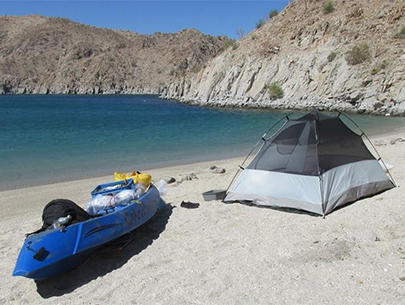
Knowing it was probably beyond my sixty-year-old self to repeat that struggle, recounted in my book Into a Desert Place, I decided to return by kayak in late October 2015, setting off south from Gonzaga Bay. My sit-on-top kayak, a large, stable Cobra Tandem, was rated to carry 600 lbs. I packed it with all the food and water (and beer), camping and fishing gear I could. In fact, I took three point-and-shoot cameras.
Overloaded, I would be at the mercy of wind and current. A sudden violent west wind, blowing offshore, can and has often proved fatal to kayakers in the Sea of Cortez. Safety required that I follow the coast as close to shore as possible.
As I was running north to south, or more accurately NW to SE, I could expect help from the prevailing NW winds at that time of year. Ideally, I’d be paddling with a moderate tailwind while riding a draining tide.

And such was the temptation to go with the tides, I several times launched in the dark, and beneath the cliffs took my chances colliding with a rock or reef as I streamed along.
And what compensations there were – breathtaking night skies, magnificent shooting stars, and mesmerizing bioluminescence. Nevertheless, it was always a relief to see the first light of dawn and feel the warmth of the sun. Daylight meant I could move in and hug the coast even closer and make a safer landing if I had to.
Temperatures were pleasant. I was often still in shorts and t-shirt when retiring to my tent at night. The sea was warmer than I expected, at least close to shore, as I found out several times when a rogue wave dumped several gallons of it into my lap.
For additional safety, I carried a Spot GPS device which allowed me to send a signal to several email addresses pinpointing my location and stating if I was OK or needed help. And to supplement my water I carried a Katadyn reverse osmosis desalinator which weighed about as much as a gallon of water but enabled me to hand pump close to a gallon of drinkable water an hour from the sea. I would love to have had both devices back when I was walking.
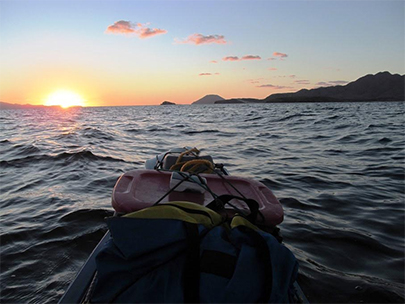
The coastline was every bit as wild and wonderful as I remembered. I recalled vividly several camp sites I had chosen all those years before… And some I chose again. A beach after a long stretch of boulders and cliffs often dictated that choice.
La Asamblea, midway on my journey, was memorable for its wonderfully colored hills and cliffs. One calm and beautiful evening, I pulled into a small, almost completely sheltered cove. Large island rocks isolated the cove and largely concealed it from the open sea. It was an unforgettable former campsite. As night approached and I was setting up my tent, a panga crept slowly north just offshore with tarps covering a cargo that rose a yard over the gunnels. Fortunately, the occupants didn’t spot me. And next morning with the wind gusting ominously and the seas building and sending waves crashing into the rocks, the panga returned south… empty. This time the occupants looked up and appeared shocked to see me. I waved, they halfheartedly waved back. Perhaps fortunately, they weren’t able to land.
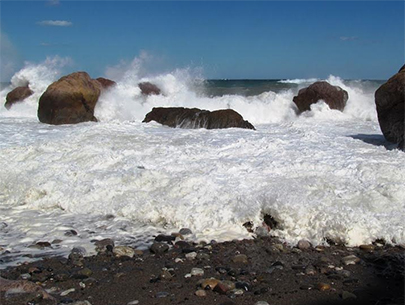
And with the wind came clouds, rain squalls, and dramatic lightning displays. Rainbows added extra color to the scene. The wind grew to near gale force. The sea became a wild confusion of roaring surf and sand-colored quivering foam. I had to move the tent and kayak three times as the waves grew bigger and more threatening. There was no way I could get clean sea water to use the desalinator. Three days later, clear skies returned and crisis averted… I was able to depart the cove, continue my journey and pump more drinking water.
The sea was alive with fish. At one point it seemed I was about to crash into a reef rising suddenly out of deep blue water. As I thrust my paddle to take evasive action, dozens of small fish leaped into the air. I was passing over a huge dark ball of sardines or anchovies. Looking back, the water erupted and boiled as a school of larger fish dashed in to take their share.
Apart from all the plastic and trash, signs of human presence on the shore were few, but I was always
glad for whatever shade and comfort
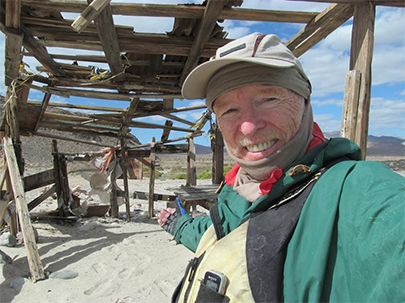
Remains of palapas on the beach made for easy shelter
the remains of a palapa offered. There were several at the
deserted fishcamp of Calamajue. I had spent nearly a week there in 1983 enjoying the extraordinary
hospitality of shark fishermen and their families. Memories and ghosts accompanied the further three
nights I camped there after pulling my kayak up on the black sandy beach… mice and kangaroo rats
overran the structures, and coyotes were abundant, gathering in howling groups in the nearby salt flats.
Contrary winds forced me to take several days to work my way around beautiful Bahia Guadalupe. My final campsite in the bay was the same one I chose in 1983. Back then, desperate for water, I departed that campsite in the dark and with disintegrating boots struggled along the rugged shore almost 20 miles to reach the town of Bahia de los Angeles. When I paddled off into the dark, November 2015, I was prepared to take several days to cover the same distance.
However, there was a perfect tail wind. And the tide was falling. Racing along, I kept on paddling and by coincidence was able to cover the same distance to exactly the same beach in LA Bay as I had in 1983. It was a dream finish. Bahia had never seemed more bursting with marine life. Whales, manta rays, turtles and fish boils lined my path.
Two of my three cameras didn’t survive, but the memory cards did. Looking back on the 100 miles I had covered, I realized just how much of Baja remains pristine, still waiting for those who seek solitude, challenge and adventure.

This a solid way to go for the Baja and Sonora travel. Reasonable rates, easy to apply and pay....

Easy buying website understands all I need

I have had this insurance 3 years easy to renew and professional staff I renew yearly to save money